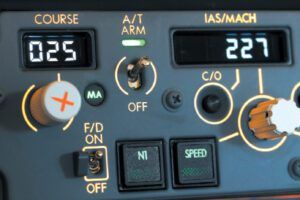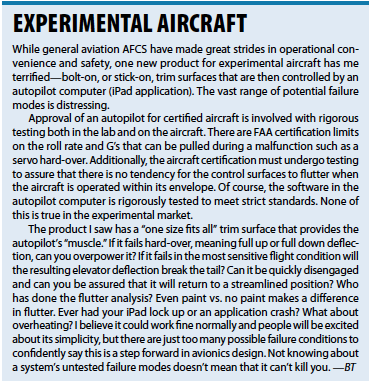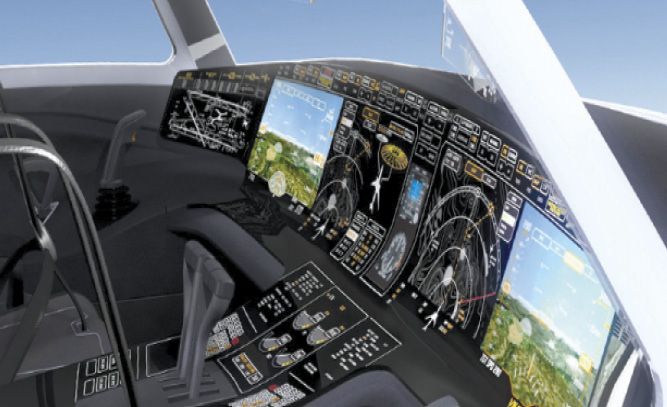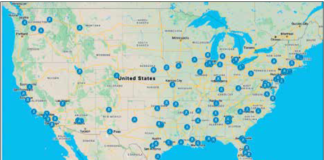Once a great add-on, wing levelers have been relegated to museums. The current automated flight control systems (AFCS or autopilots) have all the lateral and vertical modes needed to remain engaged from the initial climb to short final. Then there are the amazing capabilities in Garmin’s Collier-Trophy-winning Emergency Autoland.
Latest improvements
Where is our cockpit automation headed? Garmin’s Autonomí family of autonomous safety features sets the stage for the future, with features like Smart Glide, which assists the pilot in the event of a power failure. It recommends an airport within glide range (accounting for wind, runway length, terrain, weather, etc.), and provides critical information to the pilot. When coupled to a Garmin autopilot, Smart Glide will use best glide speed as it takes you to the airport.
Of course, Emergency Autoland carries Smart Glide to another level by landing the aircraft. Other Garmin safety enhancements are Emergency Descent Mode for automatically descending an aircraft with a nonresponsive pilot. Garmin developed Smart Rudder Bias to assist twin-engine pilots in handling an engine failure.
Yesterday’s best autopilots merely did a fine job of flying the airplane. Modern systems from most manufacturers now include envelope protection to prevent inadvertent stalls, overspeed, and excessive bank angles. Garmin’s Autonomí features take that safety oversight to the next level and give us insight into possible further enhancements.
Automatic Engagements
Is automatic autonomous engagement of safety backups a good idea? Airbus and recent Boeing systems simply take over—like the ill-fated MCAS—and can increase confusion and mental workload. But time is critical.
Other systems, like Garmin’s Safe Glide and Emergency Autoland require an initial manual action (potentially suggested by the system). I believe safety is best improved by systems that assist the pilot, not just take over, unless the system detects pilot incapacitation.
But, some systems do need to respond immediately, such as automatic rudder application after an engine failure in a twin. While these can be life savers, anecdotal evidence suggests they might induce incorrect pilot response. Thus, training on these systems is key.
Types of Future Changes
Continued enhancements will be in two varieties. One is the update process for existing aircraft and will likely include infrared (IR) vision systems optionally with heads-up displays (HUD). While light-aircraft autopilots often match their air-transport brethren, we’ll see safety improvements building on integration trends established by Garmin, and MiraCheck’s McFadden Autopilot.
The second variety will be larger modifications like full authority digital engine controls (FADEC) and autothrottles (AT). These will come about primarily in new airplane models or from the airframe manufacturers including them in existing models.
The Approved Model List (AML) has greatly simplified the process to upgrade existing installations, making upgrades available to vastly more aircraft. So, what are some of these coming modifications?
Enhanced Vision Systems
There are three types of enhanced vision—infrared sensors detect surface temperature differences, millimeter-wave radar map the surface, and displaying a mathematical model of the surface.
The first two are direct sensing and the third is a virtual reality where a computer uses stored data to generate an image of the environment. The first two have the advantage of a live view that can see transient obstructions. The third—already in common use as synthetic vision—is far less expensive but can only display what’s in the database.
Of the two direct-sensing systems, IR sensing is less expensive and has been used on business jets for several years, but it needs a quartz lens as the IR does not propagate through glass or acrylic. IR systems with or without a HUD will soon migrate down into the piston-engine market. And data-driven synthetic vision systems will surely gain better resolution and even more realistic detail.
More Safety Enhancements
The trend that Garmin established will continue. The future avionics suite will provide the services of an electronic assistant/co-pilot. Science fiction movies are often ahead of their time and R2-D2 from Star Wars is a good model for “an electronic assistant.”
A glimpse into this is already provided in MiraCheck Copilot. It is primarily a portable checklist operated via voice, but it also has a “McFadden Autopilot” feature that provides verbal nudges if you deviate in altitude or get off course, and can fetch and tell you certain information like weather, frequencies, etc.
Until recently, even the best autopilots were dumb, but skilled sticks. For example, if an aggressive vertical speed is selected for climb, the autopilot will continue to pitch up to maintain the vertical speed as the airspeed falls off, even into a stall. As noted earlier, though, recent autopilots have envelope protection that will prevent the airspeed from bleeding too far.
However, a future AFCS might give a helpful verbal nudge such as “Check airspeed” as airspeed decays. If the AFCS was in altitude hold and the airspeed was decaying with constant power, and the temperature is within the freezing range the nudge might be “Check airspeed. Possible icing.”
 Future systems will give us more information and will keep us in the loop. Parachutes or automatic engagement are ways to handle some dangerous situations, but wouldn’t it be better to avoid the situation where extraordinary action is required? Or, as Astronaut Frank Borman said, “A superior pilot uses superior judgment to avoid situations requiring the use of his superior skill.”
Future systems will give us more information and will keep us in the loop. Parachutes or automatic engagement are ways to handle some dangerous situations, but wouldn’t it be better to avoid the situation where extraordinary action is required? Or, as Astronaut Frank Borman said, “A superior pilot uses superior judgment to avoid situations requiring the use of his superior skill.”
Verbal Coaching
How many times have you gotten a vector from ATC, dutifully spun the heading bug to the new heading, but forgotten to change the autopilot mode from NAV to HDG? Future systems could recognize that situation and alert it. Or, more involved, it’d let you know if you’re on a heading to intercept final without arming approach mode.
Takeoff configuration checks are common in modern avionics suites, but future systems will add things like the wrong SID entered in the FMS for the runway heading. A Honda Jet pilot in Phoenix recently received the dreaded “Possible pilot deviation…” when he took off on Runway 25 but the SID selected in the FMS was for Runway 7. Coupling to the FMS shortly after liftoff, the Honda Jet turned eastbound instead of continuing westbound. Oops.
The future pilot might select from three levels of verbal nudges or coaching: 1. “Mother-in-law” or full-time coaching; 2. Moderate coaching; 3. Only flight-critical notifications. These will likely allow selectable voices. There should also be an option to repeat the message if it isn’t heard correctly.
CPDL
One area in which the air transport cockpit still outpaces its GA counterpart is the controller to pilot data link (CPDL). This equipment cuts down on radio congestion and reduces miscommunication on clearance and route changes. In Europe, the system uses the Aircraft Communication Addressing and Reporting System (ACARS) network. In the U.S. the data link is VHF VDL Mode 2 or even SatCom.
In the cockpit, the ATC text messages are received and sent via the FMS. Once accepted (push button) the flight plan will be entered into the FMS. Errors are reduced since ATC’s flight plan is loaded directly into the FMS. How would that work on a general aviation aircraft? It could work similarly. However, a less expensive alternative could be voice recognition of the regular mechanism.
Voice Recognition
Voice recognition (VR) has advanced considerably in the last decade. Appareo has an aviation speech recognition application that is tailored to translating ATC voice messages to text. “ATC Speak” is easier to translate to text than free speech because of the limited vocabulary. In a full-up avionics suite, VR could be put to good use. Rather than just “typing” out the message on your iPad, VR would be embedded into the avionics.

The advanced system could pull out the appropriate information and set the avionics. “Squawk 0395” would cause the transponder code to flash 0395 and the pilot would acknowledge or correct it as necessary. “Climb and maintain one-zero thousand, ten thousand” would cause the altitude preselector to flash 10000 and the appropriate vertical mode pushbutton to flash on the autopilot mode control panel.
Pushing the button on the mode control panel will acknowledge the pilot’s acceptance and command the AFCS to climb. There are many applications for voice recognition in future cockpits. One of the more spectacular would be taxi instructions.
Taxiway Guidance
As long as your GPS is operational, en-route navigation has become a snap. However, one of the more difficult tasks remains navigating on the airport itself. Sure, we’ve now got moving airport diagrams, but think about coupling voice recognition of the ATC taxi instructions.
“Runway one two—taxi via Delta Lima. Cleared to cross Runway Eight on Lima. Taxi via Taxiway November to Runway One Two. Hold short Runway One Two.” The computer would then give you a blue line on the airport depiction chart and you can track your progress to Runway 12 with a green light at Runway 8 and a red light at Runway 12. You’d still manage the readback and rudder pedals—or perhaps not—but the navigation will be simple.
Aircraft Manufacturer Changes
Within the next five to 10 years, new aircraft will see widespread incorporation of full authority digital engine controls (FADEC) and/or autothrottle (AT). AT can work with or without FADEC-controlled engines.
While the FADEC in piston aircraft does not incorporate the physical movement of the throttle(s) like the AT, FADECs have allowed the elimination of separate prop and mixture controls. FADEC and AT will continue to migrate down from the turboprops further into the piston market.
FADEC
FADEC clearly reduces pilot workload. Lycoming and Continental have developed FADECs for their larger engines, however, the largest number of FADEC engines that have been produced are the lower horsepower Rotax 915 IS engines.
Additionally, both the Diamond DA-40 NG and DA-62 have FADEC-equipped Austro AE300 engines. There is only a throttle—no propeller control or mixture control—to adjust. Also since the Austro engine is a diesel, running on Jet-A instead of Avgas, there are no magnetos to check. Another incentive for FADECs is the ability to dynamically adjust engine timing for various circumstances such as compensating for leaded vs. unleaded avgas.
Autothrottles
AT have been standard in bigger business jets going back to the Gulfstream G-IV (which had dual autothrottles) in 1987. One of the reasons AT will migrate into more aircraft is the operation is super simple. The AT only has two modes: airspeed or power. In the airspeed mode, the AT will capture and hold the selected airspeed. In the power mode, the AT will hold a specific power/thrust level.
The selection of airspeed or power is automatically determined based on the engaged AFCS mode. For every AFCS vertical mode, there is an associated AT mode. The key is if the AFCS is using the elevator (pitch) to control airspeed then the AT will be in the power mode. If the AFCS is using the elevator (pitch) to control something else like vertical speed or the glideslope, then the AT will be in the airspeed mode.
Because the AT modes are automatically selected based on the AFCS, the AT controller is rather simple. The AT controller is only used to select the desired airspeed and provide the Engage/Disengage function. The AT modes are normally displayed on the primary flight display adjacent to the AFCS modes. Garmin and IS&S have joined the ranks of Collins, Honeywell, and Safe Flight in providing autothrottle systems. Pilots often say they don’t need an autothrottle—until they fly with one. Then they quickly become believers.





